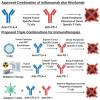Overcoming Immune Evasion in Melanoma
- PMID: 33256089
- PMCID: PMC7730443
- DOI: 10.3390/ijms21238984
Overcoming Immune Evasion in Melanoma
Abstract
Melanoma is the most aggressive and dangerous form of skin cancer that develops from transformed melanocytes. It is crucial to identify melanoma at its early stages, in situ, as it is "curable" at this stage. However, after metastasis, it is difficult to treat and the five-year survival is only 25%. In recent years, a better understanding of the etiology of melanoma and its progression has made it possible for the development of targeted therapeutics, such as vemurafenib and immunotherapies, to treat advanced melanomas. In this review, we focus on the molecular mechanisms that mediate melanoma development and progression, with a special focus on the immune evasion strategies utilized by melanomas, to evade host immune surveillances. The proposed mechanism of action and the roles of immunotherapeutic agents, ipilimumab, nivolumab, pembrolizumab, and atezolizumab, adoptive T- cell therapy plus T-VEC in the treatment of advanced melanoma are discussed. In this review, we implore that a better understanding of the steps that mediate melanoma onset and progression, immune evasion strategies exploited by these tumor cells, and the identification of biomarkers to predict treatment response are critical in the design of improved strategies to improve clinical outcomes for patients with this deadly disease.
Keywords: T-VEC; adoptive T-cell therapy; anti-CTLA-4; anti-PD-1; anti-PD-L1; immune checkpoint blockade therapy; immunotherapy; melanoma; melanoma immune evasion.
Conflict of interest statement
The authors declare no conflict of interest.
Figures







Similar articles
-
Future perspectives in melanoma research : Meeting report from the "Melanoma Bridge". Napoli, December 1st-4th 2015.J Transl Med. 2016 Nov 15;14(1):313. doi: 10.1186/s12967-016-1070-y. J Transl Med. 2016. PMID: 27846884 Free PMC article.
-
Talimogene laherparepvec treatment to overcome loco-regional acquired resistance to immune checkpoint blockade in tumor stage IIIB-IV M1c melanoma patients.Cancer Immunol Immunother. 2020 May;69(5):759-769. doi: 10.1007/s00262-020-02487-x. Epub 2020 Feb 12. Cancer Immunol Immunother. 2020. PMID: 32052079 Free PMC article.
-
Next generation of immunotherapy for melanoma.J Clin Oncol. 2008 Jul 10;26(20):3445-55. doi: 10.1200/JCO.2007.14.6423. J Clin Oncol. 2008. PMID: 18612161 Review.
-
Current and future roles of targeted therapy and immunotherapy in advanced melanoma.J Manag Care Spec Pharm. 2014 Apr;20(4):346-56. doi: 10.18553/jmcp.2014.20.4.346. J Manag Care Spec Pharm. 2014. PMID: 24684639 Free PMC article. Review.
-
Drug-induced sarcoidosis-like reaction in adjuvant immunotherapy: Increased rate and mimicker of metastasis.Eur J Cancer. 2020 May;131:18-26. doi: 10.1016/j.ejca.2020.02.024. Epub 2020 Apr 2. Eur J Cancer. 2020. PMID: 32248071
Cited by
-
A Review of Current and Pipeline Drugs for Treatment of Melanoma.Pharmaceuticals (Basel). 2024 Feb 7;17(2):214. doi: 10.3390/ph17020214. Pharmaceuticals (Basel). 2024. PMID: 38399429 Free PMC article. Review.
-
The promotive role of lncRNA MIR205HG in proliferation, invasion, and migration of melanoma cells via the JMJD2C/ALKBH5 axis.PLoS One. 2024 Jan 22;19(1):e0290986. doi: 10.1371/journal.pone.0290986. eCollection 2024. PLoS One. 2024. PMID: 38252669 Free PMC article.
-
Metastatic melanoma to the proximal ureter.Urol Case Rep. 2023 Aug 24;50:102543. doi: 10.1016/j.eucr.2023.102543. eCollection 2023 Sep. Urol Case Rep. 2023. PMID: 37664533 Free PMC article.
-
Non-viral Gene Therapy for Melanoma Using Lysenin from Eisenia Foetida.Adv Sci (Weinh). 2024 May;11(17):e2306076. doi: 10.1002/advs.202306076. Epub 2024 Mar 6. Adv Sci (Weinh). 2024. PMID: 38445883 Free PMC article.
-
Deep learning-based scoring of tumour-infiltrating lymphocytes is prognostic in primary melanoma and predictive to PD-1 checkpoint inhibition in melanoma metastases.EBioMedicine. 2023 Jul;93:104644. doi: 10.1016/j.ebiom.2023.104644. Epub 2023 Jun 7. EBioMedicine. 2023. PMID: 37295047 Free PMC article.
References
Publication types
MeSH terms
Grants and funding
LinkOut - more resources
Full Text Sources
Medical
Research Materials

